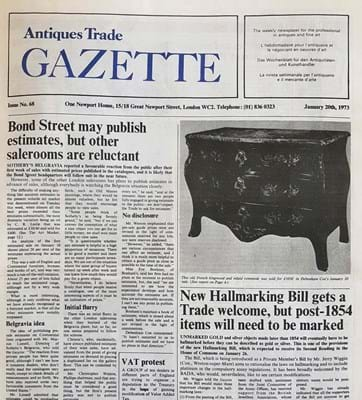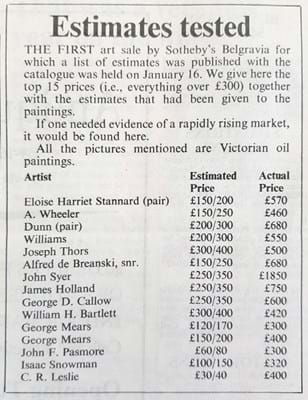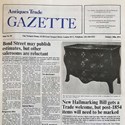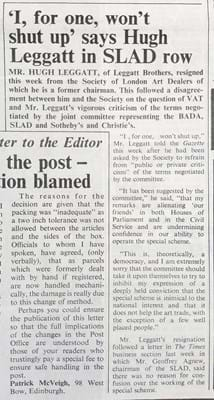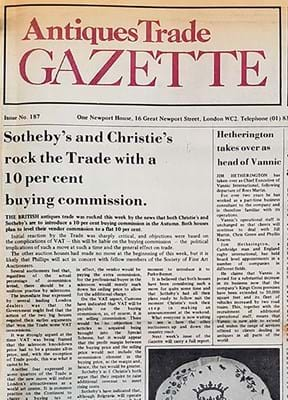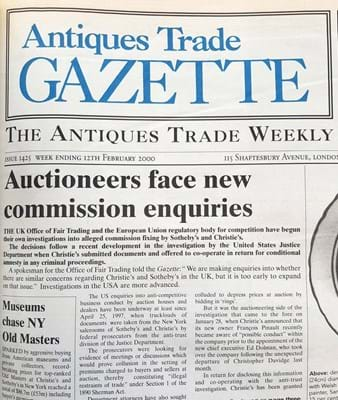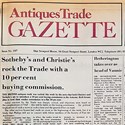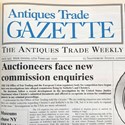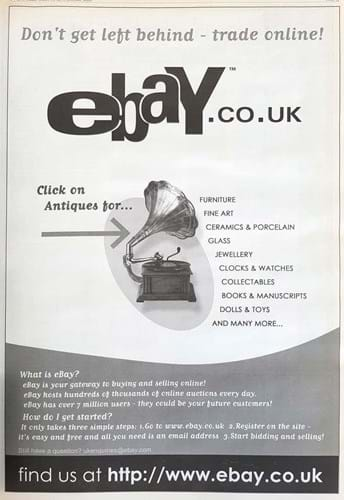The implications of the UK joining the European Economic Community in the early 1970s and of leaving what later became the European Union in the 2020s provide the book-ends for 50 years of ATG’s coverage of the art and antiques business.
Plenty else happened in-between, of course, and it is all documented on the pages that follow covering half a century of fairs, dealerships, auctions, personalities, trade associations, regulations and the occasional art crime.
Back when ATG started, however, one story dominated.
VAT’s a tricky one
“The application of Value Added Tax to dealing in antiques could kill London as the world’s art centre and put hundreds of dealers out of business,” the lead article warned on the front page on ATG issue number one in 1971.
The furore over the introduction of VAT as a result of EEC membership featured regularly in the Gazette in the early years with many main headlines dedicated to the topic.
Trade associations lobbied and thrashed out an arrangement which turned out to be an exercise in not pleasing everyone all of the time. Angry letters to ATG from outraged readers followed and a declaration of “I, for one, won’t shut up” from a livid Hugh Leggatt as he quit the Society of London Art Dealers, of which he was a former chairman, in disgust.
Nonetheless, VAT duly arrived in 1973 and the trade kept trading and London continued to fare well enough as a hub for the art market, and, although it would later be overtaken by New York, it would be unfair to blame that development solely on the arrival of VAT.
To help dealers with their VAT accounting ATG reacted by creating a new product, a snappily-named The Special Scheme VAT Stock Book. This Customs & Excise-approved set of accounting sheets contained all 13 columns required by Appendix C of VAT Notice 712, along with extra columns for a dealer’s internal use, and came in a special ring binder. It proved rather popular.
While software accounting packages would later offer a less labour-intensive solution, it was still in demand decades later and we printed the final set of refill sheets just a couple of years ago. We even received an enquiry last month from a dealer eager for more – alas, we had to break the news to him that the The Special Scheme VAT Stock Book was no longer in stock.

March 1973: ATG introduces a special VAT Stock Book to help dealers with their accounting, a service we were to run for more than 45 years. The most recent request for more refills arrived last month (August 2021). Sorry, but the ATG Stock Book is now permanently out of stock.
We could have added that the UK’s decision to leave the EU, which it finally went through with in 2020, was not accompanied by the removal of VAT – nor Artist’s Resale Right as some had hoped. Indeed, readers now contact us with new queries about EU taxation and import and export charges in a post-Brexit Britain.
The ramifications for London’s position in the art market will be played out in the years ahead; in 2021, at least, it is difficult for some to believe that Brexit will provide a boon to the capital’s standing.
Annual accounts
Over the following pages our year-by-year account of the key stories and market developments from 1971 onwards highlight the ups and downs of an exciting and turbulent 50 years. We also include a few of the many notable objects sold and a look at some of the headlines outside of the art market to provide a dose of context.
Different stories will strike a chord with different readers, as personal memories of former times kick in. Among the moments we have documented is the introduction of auction estimates which began, like UK entry into the EEC, in 1973. At the time, Marcus Linnell, director of Sotheby’s Belgravia, told ATG: “The reaction among private people has been quite good, although I can’t see how it concerns dealers who don’t really read the catalogues very much.”
According to ATG, in the first sale at Sotheby’s that used estimates 72% of items sold for a different price. Linnell commented: “It is questionable whether any estimate is helpful in a high proportion of occasions… nevertheless I do believe firmly that when people receive a catalogue one of the most interesting aspects of it must be an indication of prices.”
Eventually other auction houses followed Sotheby’s lead, despite initially expressing scepticism of the idea. A more controversial initiative soon followed, however.
Two years later Sotheby’s, along with Christie’s, rocked the trade again. On this occasion, in June 1975, it was the announcement of a 10% buying commission. What later became known as the buyer’s premium still prompts incredulous letters to ATG to this day. At the time, dealers protested by staging walk-outs from auctions, while apparently leaving their bids with sales clerks.
Again, other auction houses reacted by saying they had no intention of charging buyers but, once more, it was not long before they caved in. It turned out that auction-goers were still happy to bid and buy under the new arrangement.
Going, going…online
Twenty years later in 1995 a different type of auction took place and it was one on which no buyer’s premium was charged. The first auction on eBay (known in its earliest days as AuctionWeb) involved the sale of founder Pierre Omidyar’s broken laser pointer. Listed for $1 as something of an experiment, it sold for $14.83 - which also made it the first online auction sleeper.
Omidyar contacted the winning bidder to ask if he understood that the laser pointer was broken. The buyer replied: “I’m a collector of broken laser pointers.”
From an unlikely beginning, online auctions and internet trading of art and antiques more generally have taken off. ATG played its part, initially by listing auction houses’ catalogues online and then launching thesaleroom.com which hosted its first auction using live bidding in 2006 – an antiques, furniture and clocks sale at Dreweatt Neate. Dealer portals also flourished and during the recent pandemic fair organisers created online versions of their events.
Hindsight is handy
As you read through the year-by-year coverage you may well be struck by the thought ‘why didn’t we see that coming and do something about it sooner?’ It is a notion that could be applied to a range of trends such as the increasing importance of the internet, the fall in value of antique furniture or Christie’s and Sotheby’s moving upmarket.
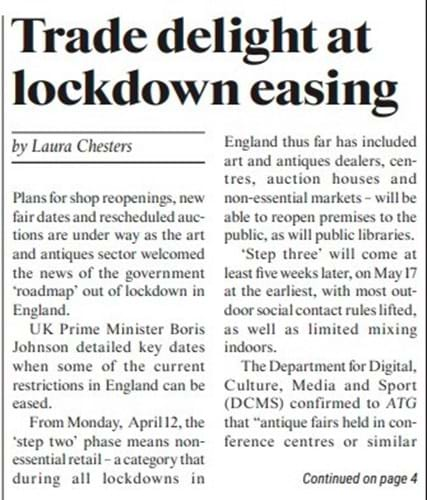
Mar 2021: The worst of the Covid-19 pandemic appears to be over, in the UK at least, as the government announces its roadmap out of lockdown for England. Devolved nations soon follow with their own more cautious plans. An appreciation for the success of the nation’s vaccine programme is one thing all members of the trade can agree on.
The same thought might also strike you as you peruse the headlines from 2003 (‘SARS causes 900 deaths’) and, nine years later, 2012 (‘First case of MERS, Middle East Respiratory Syndrome’). Both caused by forms of coronavirus, these events pointed the way to the current pandemic which, nine years after MERS, the world is still battling. Some Asian countries that had suffered with SARS were among those better prepared for Covid-19.
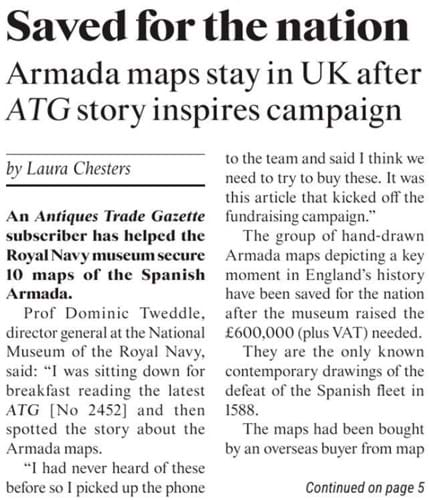
Feb 2021: Fifty years after ATG began, its stories still inspire. When subscriber Prof Dominic Tweddle, director general at the National Museum of the Royal Navy in Portsmouth, read our article about an export ban on a set of 10 Spanish Armada maps he immediately kicked off a successful £600,000 fund-raising campaign to keep them in the UK.
As we compiled the headlines from the most recent years and looked at other news stories outside the art market, one more trend stood out: the rise in frequency of extreme weather events and new record temperatures. The climate crisis is here to stay. It is to be hoped that both individuals and governments will not have cause to wonder in the future why they did not see that one coming.

